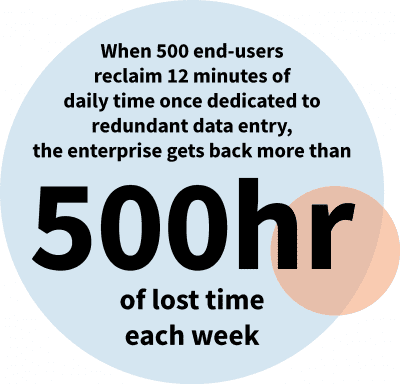Connect Data in Communications and Revenue Stacks to Improve Trust
In Part I of this series, we shared a roster of five thorny data trust challenges faced by organizations at scale. Knowing these challenges—and recognizing them in your enterprise—is a critical first step toward addressing them.
This post will provide positive counterpoints to those challenges: data trust solutions. Implementing enterprise-wide revenue data operations may be the most effective step you can take toward resolving the data governance, completeness, and quality issues that undermine data trust.
But all data integration solutions are not created equal. Where some solutions are ideal for small and mid-sized companies, others are time-tested, stable, and designed to scale—offering the kind of data security, regulatory compliance, and administrative capabilities large enterprises in regulated industries require.
Below we have listed the 5 steps we’ve found increase data trust the most.
5 steps that increase data trust
1. Reduce reliance on manual end-user data entry: connect the revenue data gathered in communications platforms with your revenue platforms
Let’s face it, end-users manually transcribing captured revenue data from one platform to another is not a viable solution. Through the implementation of a proven, scalable revenue data operations solution, enterprise CRMs (or data lakes), email, chat, and calendar data silos interconnect automatically. By making revenue data available for use in communications and analytics workflows, planning, acceleration, and engagement activities work better and the enterprise gains more trust in the data.
2. Boost and scale end-user productivity with solutions that deliver revenue data directly to preferred workflows 
When revenue data is seamlessly delivered to an end user’s preferred interface – to enable the creation, reading, updating, and deletion of that data – it eliminates the time wasted swapping between platforms. This efficiency may seem insignificant on an individual level, but at scale, the productivity potential adds up fast. When 500 end-users reclaim 12 minutes of daily time once dedicated to redundant data entry, the enterprise gets back more than 500 hours of lost time each week. That time savings can be directly reallocated toward more productive activities, including customer relationship-building—and the heightened prospect of revenue growth.
3. Reduce data transcription errors and omissions by automating revenue data sharing between platforms
By automating sharing between the communication platforms and eliminating manual revenue object re-entry, data integration solutions eliminate the risk that data will be omitted, duplicated, or inaccurately recorded. While humans are still responsible for the quality of the data they log, well-designed, rules-based automation significantly reduces the risk of errors, omissions, and duplication that compromise data quality.
4. Eliminate the security and compliance risks posed when end-users have unintended or unauthorized access to sensitive revenue data
Ensuring your connector has a pass-through architecture to bridge the gap between communication platforms without retaining it will eliminate the increased risk of revenue data exposure or breach. To ensure regulatory compliance, make sure that the solution you choose is routinely monitored and updates industry-specific regulations to prevent delivery to—or misuse by—unauthorized end-users. To further strengthen security and compliance, look for robust administrative controls that support tailored data gating to ensure it is seen only by authorized users—while providing detailed oversight of data access and use.
Recommended reading: MNPI Compliance & Regulation in U.S. and EU Markets

5. Increase enterprise ability to configure processes and data flows
High-performance data integration solutions incorporate highly-configurable administrative features that allow enterprise IT teams and administrators to monitor and control revenue data flows and processes closely. Look for a solution that provides administrators with deep insight into individual, group, and enterprise-level user behavior. Robust data ops auditing capabilities can help identify data misuse, recognize high performers, and inform strategies to improve revenue data use—and trust.
If you’d like to learn more, we encourage you to contact us for more information. We’ll set up a quick diagnostic call and schedule an informative Riva demo. You’ll gain a clear picture of Riva’s potential to reclaim wasted data entry time, measurably improve revenue data trust, enhance CRM adoption—and build a brighter future for your enterprise.
Also, if you’d like some additional background on the challenges this post helps to resolve— we encourage you to read the first installment, 5 Data Trust Challenges: How Disaggregated Data Puts Your Enterprise at Risk, of this two-part feature.
Latest Articles
- Guide to Einstein Activity Capture: All You Need to Know
- 2024 Bankers Summit: 5 Key Takeaways
- Financial Services: Mastering Customer 360 and Client Engagement for Increased Customer Lifetime Value
- Dreaming Big at Salesforce Education Summit San Diego 2024
- How to Build a Sales Cadence in 2024: Examples and Best Practices

